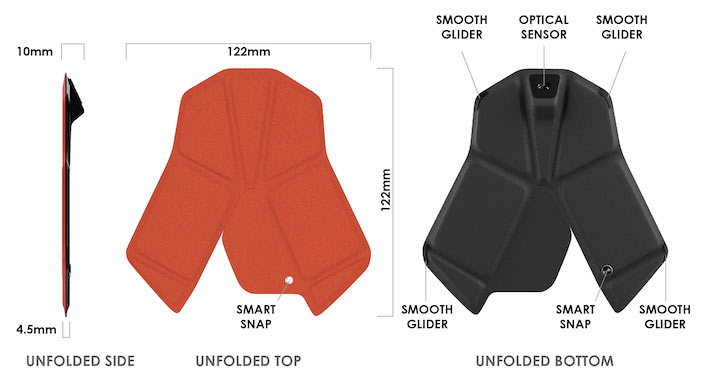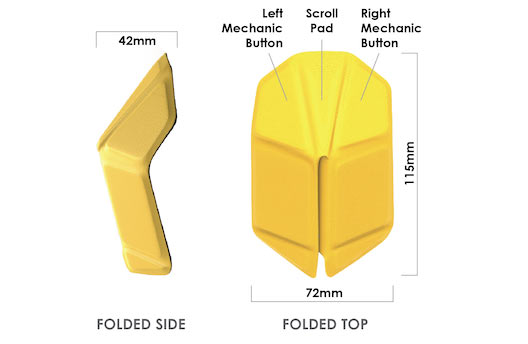Origami-Inspired Mouse Is Thin, Lightweight and Folds Flat
It is exceptionally light at 40g and portable at 4.5mm flat (plus bump).
With the digital nomad lifestyle on the rise, many professional computer users want to minimize their globetrotting tech loadouts. There are many portable and light solutions if a computer mouse is a must. However, the new Air.O mouse on Kickstarter might be the best solution, with its ultra-lightweight, incredibly thin folded form, Bluetooth connectivity, and purported ergonomics. Furthermore, when it is transformed into its mousing shape via origami magic, it doesn't look uncomfortably minuscule.
As indicated above, this is a Kickstarter project, so as usual, the promises and purported brilliance of the product must be taken with a big pinch of salt. Of course, we hope it lives up to its claims, but quite a few things can happen between the crowdfunding stage and a product shipping to customers.
To analyze this offering, let us consider the apparent positives and negatives. Starting with positives, the almost entirely flat nature of the Air.O mouse, when collapsed, is excellent to see. This form is just 4.5mm thick - about half as thick as your modern smartphone with a slim case. However, the sensor unit protrudes somewhat, presenting a 10mm angular lump. The Air.O mouse is also extremely light at 40g, rivaling some very light gaming mice with perforated and carbon fiber shells.



Some other positives regarding the Air.O are its purported strength and durability. In addition, it uses Bluetooth 5.2 with driverless connectivity and claims to have a three months battery life. The mouse also offers 'scroll wheel' functionality between the two 'button' areas; it forms a somewhat ergonomic mouse (it isn't tiny) and the array of colors/finishes in which it is in production.
We already mentioned a negative in how this mouse folds flat. For example, that 10mm angled lump might not be great if it is pressed against a screen in your bag. Another thing about the folding mechanism is that it looks somewhat 'sharp' to hold with a ridged spine in your palm when working.
Some images show the corners of the origami mouse will be the desk contact points. Though the captions in images showing this describe the corners as "smooth gliders," that is probably wishful thinking. Normal mice don't use four tiny gliders on the corners, so this will likely be a sub-optimal compromise.
The mouse is probably very quiet, as claimed. However, people often appreciate a degree of tactile and audible feedback. Similarly, failing in the ergonomics stakes, we think the 'scroll pad' area will likely not offer the excellent tactile positivity a mouse wheel provides.
Get Tom's Hardware's best news and in-depth reviews, straight to your inbox.
As for the claim of being a full-size solution as opposed to other portable mice, the Air.O is only 115mm in length when assembled and ready to point. A folding Microsoft Arc mouse (2008, with 2.4GHz dongle and 2x AAA batteries) in the office measures 112mm unfurled, so there isn't much difference in final form. However, the Microsoft model has regular microswitch buttons and a responsive wheel. There have been several refinements to Microsoft's design over the years.
The Air.O mouse crowdfunding is multiples over its initial funding goal at the time of writing, so it should make it to market and pledgers' backpacks and desks. There are still over three weeks of the campaign, and 'early birds' can pledge $49 and hopefully receive a mouse in one of 12 "Kickstarter exclusive colors" with an estimated delivery of March 2023. Please remember that backing a crowdfunding campaign isn't the same as making a pre-order purchase. Typically you have no guarantee of receiving a finished product for your pledged cash.
Readers interested in wireless productivity mice should check out our 2022 guide.

Mark Tyson is a news editor at Tom's Hardware. He enjoys covering the full breadth of PC tech; from business and semiconductor design to products approaching the edge of reason.
-
Kamen Rider Blade All this effort for a lighter mice to move around, or you can try out a trackball and transistion to that.Reply
It'd be better for you in the long term ergonomically. -
jabliese ReplyKamen Rider Blade said:All this effort for a lighter mice to move around, or you can try out a trackball and transistion to that.
It'd be better for you in the long term ergonomically.
Think traveling, not carpal tunnel. -
Kamen Rider Blade They do make travel TrackBalls.Reply
ELECOM literally has 3x models for you to choose from:
ELECOM (M-MT1DRSBK) bitra: 2.4GHz Wireless Compact-Size Thumb-Operated Trackball Mouse, 5-Button Function
ELECOM (M-MT2DRSBK) bitra: 2.4GHz Wireless Compact-Size Finger-Operated Trackball Mouse, 5-Button Function
ELECOM (M-RT1BRXBK) Relacon: BT Handheld Thumb-operated Trackball Mouse, 10-Button Function -
helper800 Reply
I would rather use a laptop trackpad than a trackball mouse. trackball mice are not the most accurate, nor are they particularly comfortable to use. They are usually heavy mice as well. I do not see the appeal for them beyond nostalgia or hanging onto something that you are used to using, and potentially for overcoming some disability.Kamen Rider Blade said:They do make travel TrackBalls.
ELECOM literally has 3x models for you to choose from:
ELECOM (M-MT1DRSBK) bitra: 2.4GHz Wireless Compact-Size Thumb-Operated Trackball Mouse, 5-Button Function
ELECOM (M-MT2DRSBK) bitra: 2.4GHz Wireless Compact-Size Finger-Operated Trackball Mouse, 5-Button Function
ELECOM (M-RT1BRXBK) Relacon: BT Handheld Thumb-operated Trackball Mouse, 10-Button Function -
Kamen Rider Blade Reply
I'll admit that there is a barrier to using the TrackBall, but once you get over it, it's really beneficial to ergonomics & avoiding RSI.helper800 said:I would rather use a laptop trackpad than a trackball mouse. trackball mice are not the most accurate, nor are they particularly comfortable to use. They are usually heavy mice as well. I do not see the appeal for them beyond nostalgia or hanging onto something that you are used to using, and potentially for overcoming some disability.
Despite how heavy they are, you usually don't move a TrackBall around in the same way you do a mouse, you just rotate the ball to where you want and click, so it has that advantage.
The force necessary to rotate a ball is pretty minimal. -
AtariAmarok ReplyKamen Rider Blade said:They do make travel TrackBalls.
ELECOM literally has 3x models for you to choose from:
ELECOM (M-MT1DRSBK) bitra: 2.4GHz Wireless Compact-Size Thumb-Operated Trackball Mouse, 5-Button Function
ELECOM (M-MT2DRSBK) bitra: 2.4GHz Wireless Compact-Size Finger-Operated Trackball Mouse, 5-Button Function
ELECOM (M-RT1BRXBK) Relacon: BT Handheld Thumb-operated Trackball Mouse, 10-Button Function
Two of those are brutally un-ergonomic. Only the third one is ergonomic at all (it's ambidextrous). The folding mouse in the news item is nicely symmetrical, which makes it ergonomic. The first two I'd toss in the trash due to the painfully bad design of the trackball and button placement where only some can actually use it. Kudos to the makers of this folding mouse to not forget making it actually usable. -
AtariAmarok ReplyKamen Rider Blade said:I'll admit that there is a barrier to using the TrackBall, but once you get over it, it's really beneficial to ergonomics & avoiding RSI.
Despite how heavy they are, you usually don't move a TrackBall around in the same way you do a mouse, you just rotate the ball to where you want and click, so it has that advantage.
The force necessary to rotate a ball is pretty minimal.
A lot of trackballs are completely unergonomic by being lopsided. They need to be symmetrical in order to be ergonomic. -
Kamen Rider Blade Reply
Sorry, the majority of the world designs for right-handed users.AtariAmarok said:A lot of trackballs are completely unergonomic by being lopsided. They need to be symmetrical in order to be ergonomic.
What can I say. -
AtariAmarok ReplyKamen Rider Blade said:All this effort for a lighter mice to move around, or you can try out a trackball and transistion to that.
It'd be better for you in the long term ergonomically.
It's better in the long-term ergonomically only if the
Kamen Rider Blade said:Sorry, the majority of the world designs for right-handed users.
What can I say.
Actually the "majority of the world" designs truly ergonomic (ambidextrous) computer pointer devices. Including the origami mouse from this Tom's Guide posting .The vast majority of mice made and sold are ambidextrous and can be used by anyone. The same is true of track pads on laptops, the overwhelming majority of which are center-mounted which means anyone can use it.
Thankfully, only a tiny minority of pointer devices are these unusable lopsided trackballs and such. Trackballs remain a tiny niche partially due to the badly designed, brutally unergonomic lopsided examples which are seen in some in the comments to this news item.
I just know googled "bestselling computer mouse" and at least the first 20 pictures showed ergonomic devices which can be used by anyone. The asymmetrical devices which are much harder to use just do not sell very well.
Making a pointer device left-handed only or right handed only is unnecessary, and it turns out it's hardly ever done. Quite understandably.
A badly-designed trackball is no substitute for a good symmetrical and ergonomic mouse such as this origami one. -
Kamen Rider Blade Reply
Sadly, the vast majority of mice I see are either Right-handed or Universal Ambi models in a 50/50 splitAtariAmarok said:Actually the "majority of the world" designs truly ergonomic (ambidextrous) computer pointer devices. Including the origami mouse from this Tom's Guide posting .The vast majority of mice made and sold are ambidextrous and can be used by anyone. The same is true of track pads on laptops, the overwhelming majority of which are center-mounted which means anyone can use it.
Thankfully, only a tiny minority of pointer devices are these unusable lopsided trackballs and such. Trackballs remain a tiny niche partially due to the badly designed, brutally unergonomic lopsided examples which are seen in some in the comments to this news item.
It's ergonomic for right-handers. And ELECOM makes some Left-handed Trackballs as well if you look at their full lineup.
I just know googled "bestselling computer mouse" and at least the first 20 pictures showed ergonomic devices which can be used by anyone. The asymmetrical devices which are much harder to use just do not sell very well.
I literally went to Google's Top 20 selling mice, and half of them were right-handed only mice.
The other half were ambidextrous mice.
Making a pointer device left-handed only or right handed only is unnecessary, and it turns out it's hardly ever done. Quite understandably.
I disagree, go look at many of the popular mice makers, there are plenty of "Right-Handed" only mouse, its' quite common actually.
Go look at Logitech, Razer, Corsair, etc.
Plenty of Right-Handed only mice.
A badly-designed trackball is no substitute for a good symmetrical and ergonomic mouse such as this origami one.
It's badly designed only if you care about Ambidextrous or Left-handedness.
Just because it doesn't suit your desires doesn't mean it's bad. It just wasn't made for you.
~90% of Humanity is Right-Handed.
< 1% of Humanity is Ambidextrous.
The remaining ~9% is Left-handed.
Those are the cold hard facts.
